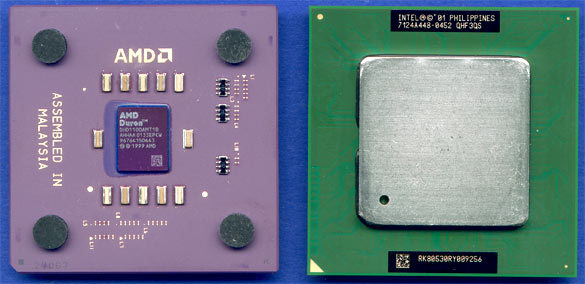Lo-Cost Duel: Duron 1100 vs. Celeron 1200
Priced To Go: Duron 1100 & Celeron 1200
Currently no CPU offers more performance for less than $150. AMD and Intel unveil their fastest low-cost processors for the bottom end of the market. AMD expands its Duron series with a 1100 MHz variation - Intel keeps up with the competition by offering the Celeron 1200 in the same class. One thing is certain at any rate; the top models at the beginner level were never to be had so inexpensively! However, both CPUs are equipped with state-of-the-art technology and, seen in terms of value for money, are absolute front-runners - you just can't get more power for your money. Among these, the AMD Duron 1100 wins honorable mention: it only costs $102 and fits into all Socket 462 boards (Socket A). That makes it the ideal upgrade solution without giving rise to additional costs. What's more, the speed increase over an older AMD processor - of about 600 MHz - is immediately noticeable. Things are a little different with the Intel Celeron 1200: It needs a special board that supports the Tualatin core. Those boards have only been on the market for about 10 weeks. The Celeron 1200 will only work with a motherboard that is equipped with an Intel 815 EPT, Intel 810 (B2 stepping) or VIA Apollo Pro 133T chipset. That makes this CPU unsuitable for an upgrade. The market situation results in another minus - comparable boards with Socket 370 for the Intel Celeron cost at least $140.
Left, the AMD Duron 1100 with the Morgan core; right, the Intel Celeron 1200 with the Tualatin core. On the Celeron, a large piece of sheet metal covers up the tiny CPU core.
PC manufacturers, on the other hand, have a much easier time of it. They can put together a fairly inexpensive PC system with an Intel processor and, on top of this, gain attention with the convincing addition of "1200 MHz". This type of PC system flies off the shelves at prices of approximately $650 to $750 - especially when large, well-known discount superstores offer PCs by the hundreds of thousands. The lessl-informed customer, after all, couldn't care less which CPU or motherboard his cheaply got bargain PC has - the main thing is that he got lots of Megahertz and Gigabytes for a song.
Blow-up of the AMD Duron 1100's CPU core (Morgan).
AMD Duron Vs. Intel Celeron: A Fair Fight
| Manufacturer | AMD | Intel |
|---|---|---|
| Processor | Duron 1100 | Celeron 1200 |
| CPU-Core | Morgan | Tualatin |
| DIE | 0.18 Micron | 0.13 Micron |
| CPU-Platform | Socket 462 | Socket 370 |
| Bus Signal Protocol | EV6 | GTL+ |
| Front Side Bus | 100 MHz | 100 MHz |
| L1 Cache | 128 kB | 32 kB |
| L1 Cache Clock | CPU Clock | CPU Clock |
| L2 Interface | 64 Bit | 256 Bit |
| L2 Cache | 64 kB | 256 kB |
| L2 Cache Clock | CPU Clock | CPU Clock |
| L2 Cache Range | 64 GB | 64 GB |
| Instruction Extensions | ||
| MMX | yes | yes |
| 3D Now | yes | no |
| 3D Now+ | yes | no |
| SSE | yes | yes |
| SSE2 | no | no |
| Electrical Specifications | ||
| Multi processor | no | no |
| Vcore | 1.45 to 1.75 V | 1.30 to 1.65 Volt |
| Thermal Design Power | 41 Watt | 27 Watt |
| Electrical Current | 46 Ampere | 48 Ampere |
| Thermal diode | yes | yes |
Comparison of the two low-cost processors. The Intel Celeron 1200 has the Tualatin core and is manufactured according to the 0.13 micron process.
In a comparison of the rivals' specification sheets, it transpires that the two processors have completely different features. While the Intel Celeron 1200 is equipped with a 32 kB L1 cache, the AMD Duron 1100 relies on a cache which, at 128 kB, is four times as large. But the L2 cache tells a different story: Intel equips the Celeron 1200 with 256 kB, making it identical to the Tualatin version of the Intel Pentium III/1133. AMD provides an L2 cache that only holds 64 kB. Even now, the question arises: How noticeable is the different cache size in practice? In the connection of the processors to the front side bus, the two CPUs are equal, both working on 100 MHz. Consideration of AMD's and Intel's top models, which work with an FSB speed of more than 100 MHz, begs the question of whether the manufacturers are not artificially limiting the clock speed to 100 MHz in order to distinguish themselves clearly from the high-end market - and from CPUs like the AMD Athlon XP, which are automatically much more pricey. For the home user and above all for ambitious freaks, there is still the option of overclocking. We illustrated this with our comparative test.
Tualatin Core: Intel Imitates A "Normal" Celeron
Intel has an ace up its sleeve with the Celeron 1200: although the CPU is equipped with a completely new core compared to the Celeron 1100 (the Tualatin core rather than the Cu-Mine core), there is nothing to hint at this on the outside. The Celeron 1200 conceals a modern processor that is made according to the 0.13 micron process. However, the Socket 370 platform, which is past its prime, will be obsolete within the medium term - i.e. in the foreseeable future - so at this point, only boosts in speed can be expected. However, the Celeron 1200 runs "with the handbrake on", as the front side bus and memory speed remains limited to 100 MHz. It is clear from our overclocking experiments that more speed can be coaxed out of the processor. If the memory speed is set at 133 MHz, the Celeron shows high performance rates and edges closer to the Pentium 4 at the same speed.
Get Tom's Hardware's best news and in-depth reviews, straight to your inbox.
But in the final balance, it must be acknowledged that the Celeron 1200 can be recognized by its new housing with the large piece of sheet metal covering it. The "old" Intel Celeron 1100, on the other hand, leaves the CPU core completely free.
Current page: Priced To Go: Duron 1100 & Celeron 1200
Next Page Test Configuration: Special Features

